
After several months of sitting on its runway wheels, BLOODHOUND SSC is now back up on blocks, with the wheels and brakes removed and stripped down, as we prepare to fit the desert running gear.
There are 2 bits of good news from stripping down the Car’s runway suspension. The technical good news is that everything has worked exactly as we expected, easily coping with extremes of temperature (up to 1000 deg C for the carbon disc brakes) and high loads (several tonnes through each of the ‘pull rods’ that connect the suspension uprights to the coil-and damper units).
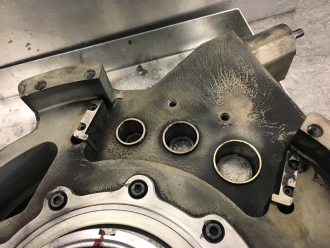 The ‘race car’ look
The ‘race car’ look
In the age of reliable and high-performance road cars, it’s easy to take this for granted, but car manufacturers spend years and millions of pounds to develop and test their cars. By contrast, BLOODHOUND SSC is a unique hand-built prototype which completed its first test runs at Newquay late last year. The fact that it’s all worked so well is a huge testament to the expertise of our design and engineering team. It’s a result of world-class engineers building a world-class car.
The other bit of good news is more emotive. As we strip down bits of the world’s most advanced straight-line racing car, it’s exciting to see the various components in their ‘used’ condition. This is how racing cars are meant to look, discoloured and heat-mottled, after achieving remarkable things at remarkable speeds. For BLOODHOUND, this is the first step in our ‘race’ to 1000 mph, and it’s looking great so far.
With the runway suspension removed, we can now start to test-fit various bits of the high-speed bodywork. One of the more important elements of protecting the Car at high speed is the carbon fibre liners for the front wheel bays. As the Car tears across the dry mud lake track at Hakskeen Pan, the supersonic airflow will cause a huge dust storm around the wheels, and these carbon fibre liners are the only thing between the wheels and the Car’s interior.
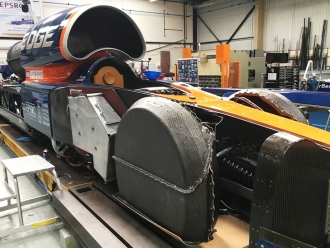 Keeping the storm at bay
Keeping the storm at bay
Try to imagine what’s going on in the front wheel bays at 500+ mph, which is the target for our first desert tests. When the Car is travelling at 500 mph, the bottom of the wheel is momentarily stationary on the ground, and the centre of the wheel is travelling at 500 mph, so the top of the wheel is doing… 1000 mph (about 1.4 times the speed of sound) inside the wheel bay. That’s 1000 mph in an enclosed space in a thick dust storm.
The wheel arch liners have to protect the inside of the Car from this supersonic dust-filled version of hell. That’s what I mean by being an ‘important element’ of the bodywork.
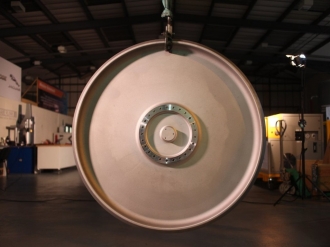 Unique wheels
Unique wheels
As we build up the desert suspension, we’ll be fitting the high-speed metal desert wheels. These have been designed (and tested) to be safe at over 1000 mph, with a safety margin to cope with bumps and side-loads at maximum speed. The biggest single load on the wheels comes from their sheer speed of rotation.
At 1000 mph (1600 km/h, 447 metres/sec), they are turning at over 10,000 times a minute, 170 rotations per second, which produces a load of 50,000 (yes, fifty thousand) times the force of gravity at the wheel rim. That’s why the wheels have to be solid metal, and why it took 6 years to design, build and test them to this extraordinary standard. They really are a unique piece of race car technology.
The high-speed brakes also have to cope with these huge rotational speeds and forces. Last year at Newquay we used carbon disc brakes for our 200 mph tests, but we’ll need something stronger at supersonic speeds. Hence the desert brakes use steel discs. While the braking capacity of steel is not as good as the carbon discs used in most race cars, or even the cast iron used in most normal road cars, it’s good enough to stop the Car from slow speed (below 200 mph). More importantly, the steel is strong enough to survive the mechanical torment of spinning at 1000 mph. The desert suspension will have brakes on the front wheels only: the rear wheels sit outside the bodywork, so we’re removing the rear wheel brakes to minimise the drag. Given that we’re talking about going much faster than we did in Cornwall, this might sound at best counter-intuitive and at worst, faintly suicidal.
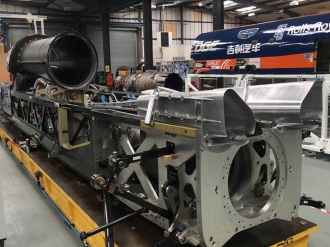 Stopping is just as important
Stopping is just as important
In fact, the wheel brakes will only be used in the last mile of the run, when the aerodynamic drag is very low. Above 200 mph, slowing the Car down will be done using aerodynamic drag. To increase the drag enough to stop the Car, we will have a choice of airbrakes or parachutes – we’ve fitted both for safety, as slowing down is the one bit that you have to get right every single time!
The drag parachute cans are now being test-fitted at the back end of the Car. Given the importance of stopping the Car reliably on each run, testing the ‘chutes will be a key part of our first desert runs. It would be nice to test the airbrakes as well, but they will not be fitted this year. Sadly, a couple of our composites suppliers have recently stopped trading, without having completed some bits of our high-speed bodywork. We’re busy looking for alternative suppliers right now. Just another minor speed bump on the road to 1000 mph: no-one said that building the world’s fastest race car was going to be easy.
 Nature doing it’s bit
Nature doing it’s bit
While we’re slowly getting the Car ready for the desert, mother nature is doing her part out in South Africa. The desert surface is water-laid, and each rainfall improves the surface, so a fully flooded track is good news. There was a fair bit of rain in the Northern Cape area during April, which left Hakskeen Pan mostly underwater for several days. The satellite views show a ‘natural’ view of the surface as your eye would see it and a ‘false colour’ view highlighting the water. This is the most flooding we’ve seen for several years – can’t wait to see the track once it dries out.
Our BLOODHOUND Adventure continues to make a compelling story for all ages. I was recently speaking at a dinner in Bristol, at the Ashton Gate football stadium. The audience was suitably impressed by the thought of doing 1000 mph. If BLOODHOUND SSC drove through the stadium at full speed (1000 mph = 447 metres/sec), then driving the 100+ metres length of the pitch would take less than one-third of a second. That’s faster than the human blink reflex, so BLOODHOUND at 1000 mph is literally ‘blink-and-you’ll-miss-it’.
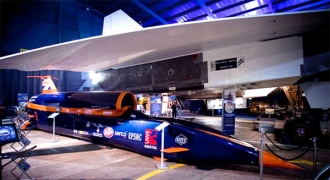 Supersonic icons for their generation
Supersonic icons for their generation
BLOODHOUND is being built just down the road from the stadium in Bristol, which makes perfect sense, given the wonderful engineering history of the place. Bristol produced Concorde, the world’s first supersonic airliner. A century before that, Brunel built the world’s largest ship, the ‘SS Great Britain’ in Bristol. Brunel also designed Bristol’s famous Clifton suspension bridge, which still stands today thanks to technology developed by Bristol engineer Mrs Sarah Guppy. That’s another reminder that engineering is not just for boys!
This point was reinforced by a visit to Hambrook Primary School, just outside Bristol, recently. The whole school was fascinated by BLOODHOUND, with the best questions coming from the girls. My personal favourite was ‘Will it actually get to 1000 mph?’. Great question from a properly enquiring mind. The honest fact is that we don’t know. All the data says it’s possible, but there’s only one way to prove it, so now we’ve got to make it happen! As we push back the boundaries of physics over the next couple of years, we’ve got a whole generation of youngsters watching our every step. No pressure then.


